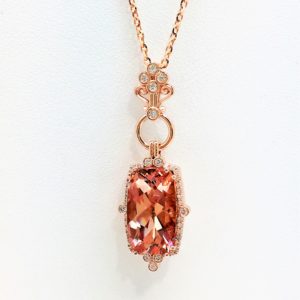Morganite is the pink to orange-pink variety of beryl, a mineral that includes emerald and aquamarine. Morganite’s color range includes pink, light pink, rose, peach, and salmon. The pink and rose tints are much more popular than the darker salmon tones. Morganite was first discovered in Madagascar in 1910. In modern times morganite jewelry gained popularity and even spotted as an alternative center stone for engagement rings. Morganite now comes mostly from pegmatite mines in Minas Gerais, Brazil. Afghanistan, Mozambique, Namibia, and the US have been minor and inconsistent sources. While it is only a minor producer today, the original Madagascar deposit still sets the standard for the best material.

Following its discovery in 1910, George Kunz proposed the name morganite at a meeting of the New York Academy of Sciences on 5 December 1910 to honor his friend and customer J.P. Morgan for his financial support for the arts and sciences, and his important gifts of gems to the American Museum of Natural History in New York and Paris. J.P. Morgan was one of the most important gem collectors in the early 1900s. Since morganite was just recently discovered compared to the other gemstones, not much history and lore are available. Some do believe that morganite is a powerful, high vibrational, universal stone of unconditional love. It helps to attract and maintain love. Holding a piece of morganite brings a sense of deep peace and joy, both within us and with the world.

